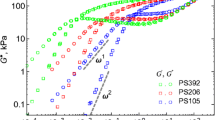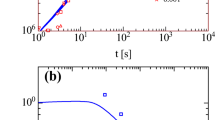Abstract
This work focuses on the linear viscoelastic behaviour at length scales shorter than an entangled strand and attempts to connect it to the nonlinear behaviour (from data in literature) in fast extensional flow where such short length scales play an important role. We have measured the linear viscoelasticity at high frequencies in the transition to glassy regime for a series of polystyrene (PS) melts and solutions. When the samples are compared at the same Tref-Tg, where Tref is the reference temperature and Tg is the glass transition temperature, their third crossover points (near the glassy regime) of G′ and G″ plots are located at the same frequency. While the unentangled styrene oligomer behaves as a solvent in the flow and rubber plateau regimes, it contributes the same as the PS melts in the transition regime, unless the chain length is close to a Kuhn segment. In fast extensional flow, using τ0 as the time scale and G0 as the modulus scale, where τ0 and G0 are both associated with the third crossover point, the normalized steady-state extensional viscosity seems to depend on the number of Kuhn segments per chain, but not on the PS fraction. This is probably due to the contribution from the styrene oligomer solvent. However, fracture may happen before the steady state if the stretched polymer chains are close to their theoretical maximum stretch ratio.










. For calculating the Rouse time (Z2τe), τe is estimated according to Fig. 1

Similar content being viewed by others

References
André A, Shahid T, Oosterlinck F, Clasen C, van Ruymbeke E (2021) Investigating the transition between polymer melts and solutions in nonlinear elongational flow. Macromolecules 54:2797–2810
Bhattacharjee PK, Oberhauser JP, McKinley GH, Leal LG, Sridhar T (2002) Extensional rheometry of entangled solutions. Macromolecules 35:10131–10148
Huang Q (2019) Exploring the mechanism of fracture for entangled polymer liquids in extensional flow. Phys Fluids 31:083105
Huang Q, Rasmussen HK (2019) Extensional flow dynamics of polystyrene melt. J Rheol 63:829–835
Huang Q, Ahn J, Parisi D, Chang T, Hassager O, Panyukov S, Rubinstein M, Vlassopoulos D (2019) Unexpected stretching of entangled ring macromolecules. Phys Rev Lett 122:208001
Huang Q, Rasmussen HK (2017) The transition between undiluted and oligomer-diluted states of nearly monodisperse polystyrenes in extensional flow. Rheol Acta 56:719–727
Huang Q, Hengeller L, Alvarez NJ, Hassager O (2015) Bridging the gap between polymer melts and solutions in extensional rheology. Macromolecules 48:4158–4163
Huang Q, Alvarez NJ, Shabbir A, Hassager O (2016) Multiple cracks propagate simultaneously in polymer liquids in tension. Physical Review Letters 117:087801
Huang Q (2013) Molecular rheology of complex fluids, PhD thesis, Technical University of Denmark
Huang Q, Alvarez NJ, Matsumiya Y, Rasmussen HK, Watanabe H, Hassager O (2013a) Extensional rheology of entangled polystyrene solutions suggests importance of nematic interactions. ACS Macro Lett 2:741–744
Huang Q, Mednova O, Rasmussen HK, Alvarez NJ, Skov AL, Almdal K, Hassager O (2013b) Concentrated polymer solutions are different from melts: role of entanglement molecular weight. Macromolecules 46:5026–5035
Ianniruberto G, Marrucci G, Masubuchi Y (2020) Melts of linear polymers in fast flows. Macromolecules 53:5023–5033
Inoue T (2006) On the relationship between viscoelastic segments and Kuhn segments: strain-induced chain orientation in fast deformation. Macromolecules 39:4615–4618
Larson RG (2004) An explanation for the high-frequency elastic response of dilute polymer solutions. Macromolecules 37:5110–5114
Laukkanen O-V (2017) Small-diameter parallel plate rheometry: a simple technique for measuring rheological properties of glass-forming liquids in shear. Rheol Acta 56:661–671
Majeste J-C, Montfort J-P, Allal A, Marin G (1998) Viscoelasticity of low molecular weight polymers and the transition to the entangled regime. Rheol Acta 37:486–499
Matsumiya Y, Watanabe H (2021) Non-universal features in uniaxially extensional rheology of linear polymer melts and concentrated solutions: a review. Prog Polym Sci 112:101325
Narimissa E, Huang Q, Wagner MH (2019) Elongational rheology of polystyrene melts and solutions: concentration dependence of the interchain tube pressure effect. J Rheol 64:95–110
O’Connor TC, Alvarez NJ, Robbins MO (2018) Relating chain conformations to extensional stress in entangled polymer melts. Phys Rev Lett 121:047801
Palade L-I, Verney V, Attané PJRa, (1996) A modified fractional model to describe the entire viscoelastic behavior of polybutadienes from flow to glassy regime. Rheol Acta 35:265–273
Park SJ, Desai PS, Chen X, Larson RG (2015) Universal relaxation behavior of entangled 1,4-polybutadiene melts in the transition frequency region. Macromolecules 48:4122–4131
Roland CM, Archer LA, Mott PH, Sanchez-Reyes J (2004) Determining Rouse relaxation times from the dynamic modulus of entangled polymers. J Rheol 48:395–403
Rubinstein M, Colby RH (2003) Polymer physics. Oxford University Press
Shahid T, Clasen C, Oosterlinck F, van Ruymbeke E (2019) Diluting entangled polymers affects transient hardening but not their steady elongational viscosity. Macromolecules 52:2521–2530
Shahid T, Huang Q, Oosterlinck F, Clasen C, van Ruymbeke E (2017) Dynamic dilution exponent in monodisperse entangled polymer solutions. Soft Matter 13:269–282
Funding
The authors received financial support from the State Key Laboratory of Polymer Materials Engineering (Grant No. sklpme2020-1–04) and the National Natural Science Foundation of China (Grant No. 52173022).
Author information
Authors and Affiliations
Corresponding author
Additional information
Publisher's note
Springer Nature remains neutral with regard to jurisdictional claims in published maps and institutional affiliations.
Rights and permissions
About this article
Cite this article
Zhong, Y., Yu, L. & Huang, Q. Investigating the linear viscoelastic behaviour at high frequencies in the transition to glassy regime for polystyrene melts and solutions. Rheol Acta 61, 689–700 (2022). https://doi.org/10.1007/s00397-022-01359-8
Received:
Revised:
Accepted:
Published:
Issue Date:
DOI: https://doi.org/10.1007/s00397-022-01359-8



